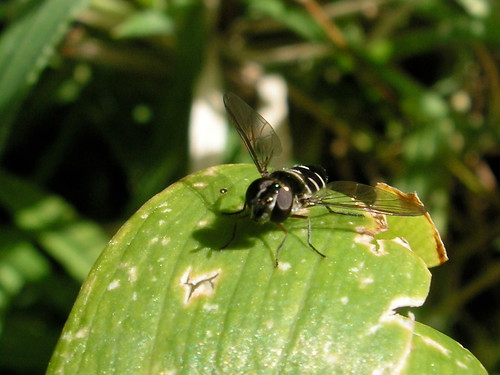Sunday, November 20, 2011
Sunday Spinelessness - Hover fly
Labels: hover-fly, sci-blogs, sunday spinelessness, Syrphidae
Sunday, July 11, 2010
Sunday Spinelessness - Love and deception in Vancouver
I think I've finally got back into the rhythm of life in Dunedin after The Big Trip, so it must be time to get back to spending a little bit of my weekend documenting some of the goings on in the spineless world. Thankfully, having gone to visit the summer I've got quite a cache of bug photos to keep the series going
Let's start by interrupting this couple, who I found enjoying summer amongst the flowers on the University of British Columbia's very impressive campus:
At first glance I thought I'd stumbled across a pair of mating bumblebees. But it's really the wrong time of year, bumblebee mating is usually restricted to the end of summer. As the days get shorter and cooler the flowers that keep a bee hive become in short supply. Honeybees get through the winter by hunkering down, but bumblebees skip it altogether. The sisterhood that runs a bumblebee nest sends out queens and males (drones) towards the end of summer, once she's mated the queen hibernates and emerges in the spring ready to set up a new nest. So, not quite sure what I was looking at, I took a closer look.
Hmmm, thats odd. Those big eyes ...
... those little, hairy antennae ...
These are flies! I think, in fact, that they are hover-flies. The bee-like appearance is no coincidence, these flies are an example of something biologists call Batesian mimicry. Despite a widely held belief to the contrary, bumblebees pack a pretty mean sting and at least some would-be predators stay away from them as a result. By appearing enough like a bumblebee to fool birds these flies get the benefit of bumblebee's sting without having to pay the cost of making the venom. Hover-flies in particular make good mimics, there are species that specialise in aping wasps and honeybees and indeed there are other bumblebee mimics.
I'm afraid I can't say very much more about these particular flies, after all the Pacific North West's fauna is entirely new to me. Perhaps the dipterous and the British Columbian wings of the of the bug-blogosphere can at least give them a name. As always, the images link to higher resolution versions.
Labels: Canada, diptera, environment and ecology, hover-fly, insects, photos, sci-blogs, Vancouver
Sunday, May 16, 2010
Sunday Spinelessness - You don't know the trouble you're in
A scene from the garden. On the left, the New Zealand Praying Mantis Orthodera novaezealandiae. On the right, a hover-fly that doesn't know how much trouble it's in.
(for those interested in the final result: the hover-fly flew off; the mantis lunged, but missed)
Labels: environment and ecology, hover-fly, might interest someone, Orthodera novaezealandiae, photos, sci-blogs, sunday spinelessness
Sunday, April 11, 2010
Sunday Spinelessness - Hover-flies
We are starting to get that feeling in Dunedin, the days are getting shorter and cooler, and we can't enjoy a sunny weekend without wondering how long it will be until we see another one. So, to cheer me up, let's use this post to celebrate a group of very summery insects, the hover-flies (family Syrphidae) .
Hover-flies rank alongside bees, both honey and bumble, as the most frequent visitors to garden flowers during summer. Thankfully for me, hover-flies don't limit themselves to well tended gardens, they are just as likely to brighten up weed infested patches:
Plenty of other flies can hover, but hover-flies make an art of it. You'll often see them suspended above a flower, their wings beating to fast to see and their heads completely motionless. As this stunning photo from wikipedia user Fir002 (whose other photos can seen here) shows, hover-flies can do all sorts of things in mid air:
Labels: diptera, environment and ecology, hover-fly, photos, sci-blogs, sunday spinelessness, Syrphidae












